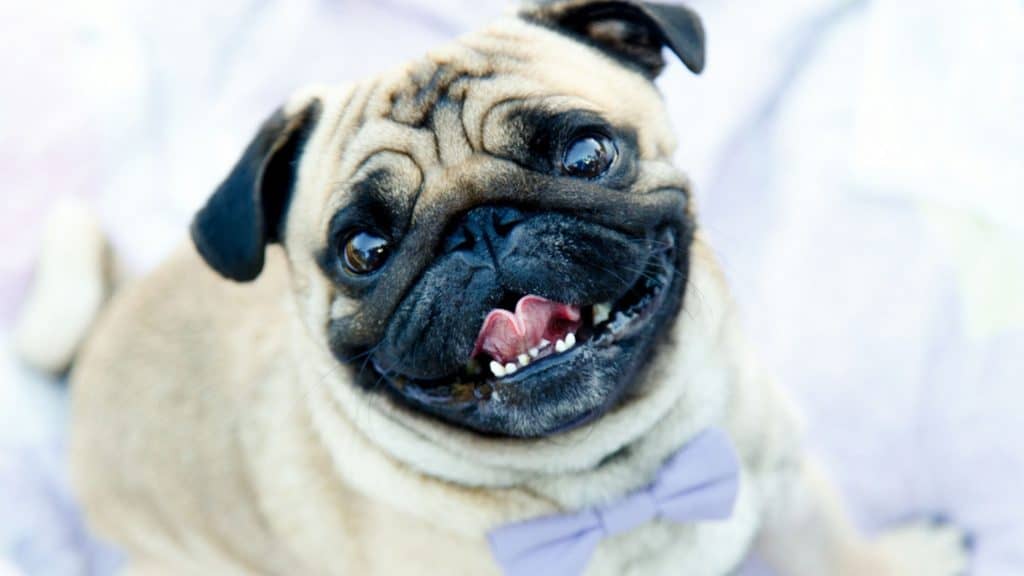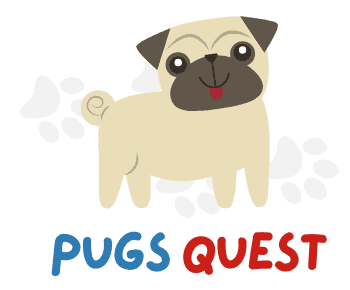
Just like us humans, Pug’s teeth need to be cleaned and looked after to avoid any nasty dental problems.
If you’re not sure how to care for your Pug’s teeth, when to brush, or what products to use, then don’t worry. We’re here to help.
We’ve put together a go-to guide about all manner of Pug teeth problems and how to avoid them.
Do Pugs Have Bad Teeth? Why do Pugs Get Teeth Problems?
Yes, Pugs could have bad teeth.
While Pugs are famously known for their squished faces and they are so cute, Pug’s facial structure and compressed jawbone can cause some teeth problems.
- Malocclusion
Malocclusion is the term used to describe teeth that do not line up properly. This misalignment can be painful for your Pug.
Many Pugs have an underbite due to their compressed jawbones that leave the upper and lower jaw growing at different rates.
- Their teeth are Overcrowding
Another reason for Pug’s bad teeth is overcrowding. Pugs have 42 teeth which are too much for their mouth.
Due to their facial structure and compressed jaw, a Pug’s set of teeth can become overcrowded in the oral cavity, resulting in a bacterial buildup that could lead to more severe gum disease.
This is because, when a Pug’s teeth become overcrowded, the root of each tooth lacks support from the jawbone. Plus with less space between each tooth, it creates the perfect environment in which plaque and bacteria can accumulate.
When this happens, it becomes a vicious cycle. It’s harder to clean overcrowded teeth and, therefore, more and more plaque and bacteria are often allowed to accumulate over time.
Eventually, this leads to inflammation, tooth loss, and gum disease.
In these cases, some teeth may need to be extracted by a veterinary surgeon to make your Pug more comfortable.
Should You Brush Your Pugs Teeth? How Often Do You Clean Pug’s Teeth?
As a brachycephalic breed (other brachycephalic breeds include Bulldogs, Boston Terriers, and Shih Tzus), Pugs are prone to developing certain types of dental problems.
That’s why regularly cleaning your Pug’s teeth is so important! It’s not just us people who need to keep our teeth and gums healthy. But, some pet owners still choose not to prioritize the dental hygiene of their animals.
You’d better brush your Pugs’ teeth 2 to 3 times a week, make sure to take them for professional dental cleanings once a year.
Failing to provide our pets with adequate dental care will lead only to health problems.
How to Know If Your Pug’s Mouth is Healthy
A healthy mouth should be free of plaque and tartar. If you’re not quite sure what plaque and tartar look like, look out for any sticky, scaly, or hard substances on the teeth.
Plaque might seem harmless but over time this sticky substance erodes the enamel on your dog’s teeth. Plaque that turns to tartar can have even more destructive effects.
Tartar travels under the gum line and damages the root of your Pug’s teeth leading to tooth decay, gingivitis, periodontal disease, infection, and tooth loss.
In very very severe cases an infection could develop into sepsis (a potentially fatal condition).
A healthy mouth also includes 42 teeth of relatively even distribution.
Your Pug’s teeth should all be intact (not jagged, chipped, or broken in any way). Finally, make sure that your Pug’s tongue is moist, pinkish in color, and free of lumps, bumps, sores, or cuts. Gums are usually a combination of black or pink.
Warning signs of unhealthy gums include:
- Pale gums
- Bright-red tissue
- Lumps, bumps, and spots
- Discoloration
It is not always easy to spot discoloration in a Pug’s gums (especially if your Pug already has gums with a range of black and pinkish tones). If in doubt, it’s always best to check any suspected discoloration with your local vet.
How to Keep Your Pug’s Teeth Clean
The best way to avoid dental problems altogether is to brush your Pug’s teeth regularly as part of a consistent oral hygiene routine.
At-home dental care is essential for all Pugs and will prevent the buildup of excess plaque that could lead to periodontal disease and infection.
If you leave your Pug for more than three days without brushing their teeth, this plaque could turn to hard tartar (which is much, much, harder to remove).
As well as brushing there are many products you can use to help keep your Pug’s teeth clean and fresh. Let’s take a look at all the options.
1. Brushing
Brushing prevents plaque buildup. We should brush our Pug’s teeth as often as possible (even if they kick up a fuss). Try to brush your Pug’s daily (if not twice daily) for ultimate protection against plaque.
Make sure to use dog-friendly toothpaste (no Colgate allowed) and a doggie toothbrush that’s appropriately sized for the shape and composition of your Pug’s mouth.
If your Pug is super fussy, you might have better luck using a flavored canine toothpaste. Did you know you can even get chicken flavored toothpaste? I know… yuck, right? But Pugs will love it.
Brush for two or three minutes once or twice per day. Once you’ve finished brushing, wipe away any excess paste and you’re good to go!
It really is that simple.
Here is a video to teach you a step-by-step guide to brushing your Pug’s teeth.
2. Dental wipes
Dental wipes are a great way to remove plaque from your Pug’s teeth.
You can use doggie dental wipes as an on-the-go solution or for a Pug that really, really doesn’t like having their teeth brushed.
You won’t be able to get into all the gaps, cracks, nooks, and crannies but wipes are a great alternative solution nonetheless.
3. Dental treats & chews
Dental treats are great for general oral health maintenance.
These treats are fun for your Pug to chew on and are specifically designed to help remove plaque and promote fresh breath.
Many of these products contain targeted enzymes to promote oral health and can be readily found in pet shops and veterinary practices.
4. Supplements
Did you know that you can get oral supplements to support your Pug’s dental health?
These supplements prevent bad breath and reduce plaque so that your Pug (and your nose) can enjoy the freshness.
You’ll be able to find everything from sprays to drops and powders that can be added to your Pug’s water or food bowl. Easy!
5. Professional Cleanings
Finally, a professional cleaning from time to time will make sure that your Pug’s mouth is fresh as a daisy and in tip-top condition.
Plus, your dental hygienist or veterinarian will be able to let you know if they think your Pug is experiencing any more serious issues that require further attention.
Your vet is the best person to ask about tooth decay, infection, and disease.
They will be able to carry out all the necessary testing and prescribe an appropriate treatment plan for your Pug.
Keep Your Pug’s Teeth Clean!
Keeping your Pug’s teeth clean and fresh is the best way to prevent dental problems like gum disease, and tooth decay.
Daily brushing should be part and parcel of all Pug owner’s routines. Plus, with so many products and options out there, there’s really no reason not to!
